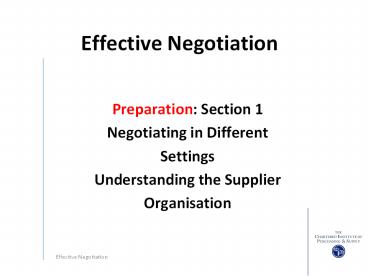Effective Negotiation - PowerPoint PPT Presentation
Title:
Effective Negotiation
Description:
Effective Negotiation Preparation: Section 1 Negotiating in Different Settings Understanding the Supplier Organisation – PowerPoint PPT presentation
Number of Views:4978
Avg rating:3.0/5.0
Title: Effective Negotiation
1
Effective Negotiation
- Preparation Section 1
- Negotiating in Different
- Settings
- Understanding the Supplier
- Organisation
2
Learning Outcomes
- At the end of this session candidates will be
able to - Define the term negotiation
- Describe the different phases of negotiation in
order to the identify the range of preparatory
activities - Identify and describe the collaborative and
distributive approaches to negotiating in
business in order to understand different
negotiation settings - Compare and contrast the collaborative and
distributive approaches to negotiation so as to
assess the types of variables to be used in a
negotiation - Identify the factors that influence the approach
taken in negotiations in order to understand the
supply context - Review the purchasing context for negotiations in
order to understand the supplier organisation - Identify the range of supplier information
required to underpin a negotiation - Apply a Porter's 5 Forces framework to a market
to enable evaluation of the competitive
environment
3
Negotiation Definitions
- NEGOTIATION IS
- The process whereby two or more parties decide
what each will give and take in an exchange
between them - Rubin and Brown (1975)
- An occasion where one or more representatives of
two or more parties interact in an explicit
attempt to reach a jointly acceptable position on
one or more divisive issues about which they
would like to agree - Gottschal (1973)
4
Negotiation Definitions
- NEGOTIATION IS
- Any form of verbal communication in which the
participants seek to exploit their relative
competitive advantages and needs to achieve
explicit or implicit objectives within the
overall purpose of seeking to resolve problems
which are barriers to agreement - Lysons (1993)
5
Negotiation Situations
- To discuss with a view to mutual settlement
(Collins English Dictionary) - Two or more parties
- Conflict of interest
- Willingness to negotiate
- Need to seek agreement
- Better outcome through influence and persuasion
- Parties seeking to satisfy tangible and
intangible outcomes
6
Phases of Negotiation(Diagram from workbook by
Tracey G Harwood)
Source derived from Greenhalgh, 2001 (in Lewicki
et al, 2003)
7
Phases of Negotiation
KENNEDY'S FOUR PHASES PLAN/PREPARE DEBATE BARGAIN
PROPOSE
Source derived from Kennedy (1989), Everything
is Negotiable
8
Phases of Negotiation
A NEGOTIATION PROCESS falls into THREE
DISTINCT PHASES PRE-NEGOTION ACTUAL NEGOTIATION
and POST-NEGOTIATION
Source derived from Lysons and Gillingham (2003)
Purchasing and Supply Chain Management
9
Phases of Negotiation
- A NEGOTIATION PROCESS consists of
- THREE IMPORTANT FACTORS
- THE NEGOTIATORS
- A NEGOTIATING SITUATION
- TIME
Source derived from Lysons and Gillingham (2003)
Purchasing and Supply Chain Management
10
Effective Negotiation
- Three criteria are identified for effective
negotiation that it be - A wise agreement satisfactory to both sides
- Efficient costs and time appropriate
- Harmonious fosters good relationships
- Source derived from Fisher and Ury (1983)
Getting to Yes
11
Collaborative Approach
- Agreement is reached by
- Finding common goals
- Transparent agenda and issues
- Acceptable solutions for both parties
- Ethical
- Sharing risk and cost savings
- Impasse escalation process if necessary such as
mediation or arbitration - Friendly, non-aggressive approach
12
Distributive Approach
- Negotiation is played out by
- Competing goals
- Secrecy and hidden agendas
- Low trust
- One side winning and the other losing
- Head-to-head adversarial approach
- Competitive and inflexible negotiation
- Characterised by conflict, disagreement and
miss-information - Impasse may end in no deal or litigation
13
Negotiation Outcomes
BUYER (OR EMPLOYEE)
WIN LOSE
Both are Buyer loses winners
Seller wins Seller loses
Both parties Buyer wins
lose
WIN
SELLER (OR MANAGER)
LOSE
14
NEGOTIATIONS
- Essential skills and qualities include
- Questioning and active listening
- Observation
- Assertiveness
- Influencing
- Persuading
- Patience
- Sense of humour!
- Ethics
15
Drivers for Change in Purchasing
- Technological advances
- Quality and customer focus
- Globalisation
- Insourcing and outsourcing
- Strategic cost management
- Supplier relationship development and network
management - Value chain and added value focus
16
Impact on Negotiation
- Fluctuating prices
- Time preferences
- Dynamics in exchanges
- Relative interests of each party
- Risk aversion factors
- Bargaining power
- Constraints of macro-environment and
organisational policies and procedures
17
Negotiation
- Pre-contract
- Contract agreement
- Contractual and relationship review
18
Porters 5 Forces(Michael Porter, 1985)
New Market Entrants, eg entry
ease/barriers geographical factors
incumbents resistance new entrant strategy
routes to market
Supplier Power, eg brand reputation
geographical coverage product/service level
quality relationships with customers
bidding processes/ capabilities
Threat of new entrants
Rivalry among existing competitors e.g.
number/size of firms, industry size and trends,
fixed v variable cost bases, product/ service
ranges, differentiation, strategy
Bargaining power of buyers
Bargaining power of suppliers
Buyer Power, eg buyer choice buyers
size/number change cost/ frequency
product/service importance volumes, JIT
scheduling
Product and Technology Development, eg
alternatives price/quality market distribution
changes fashion and trends legislative
effects
Threat of substitute products or services
19
RISK
- Risk is in the future
- The result of probability of something happening
and the impact when it occurs - Risk is around us all the time
- Some risk is predictable
20
RISK
- There are 4 ways to attack risk
21
RISK
- What is the likelihood of risk happening and what
are the possible consequences
22
PESTLE
- Political
- Economic
- Socio-cultural
- Technological
- Legislative and Regulatory
- Environmental and ecological
23
RISK from external environment PEST, PESTLE,
DEEPLIST
24
RISK
- SWOT
25
RISK Probability and impact

